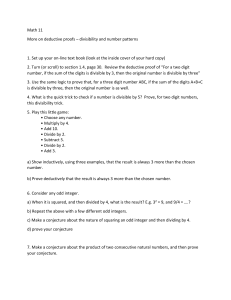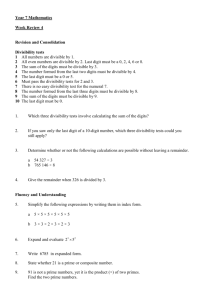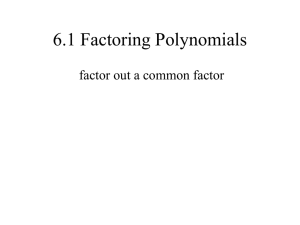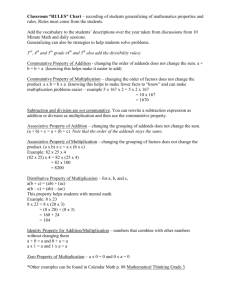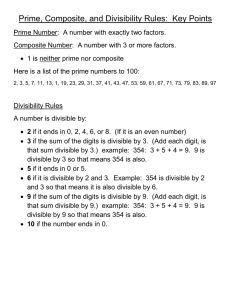1.1 Divisibility by 10, 5, and 2
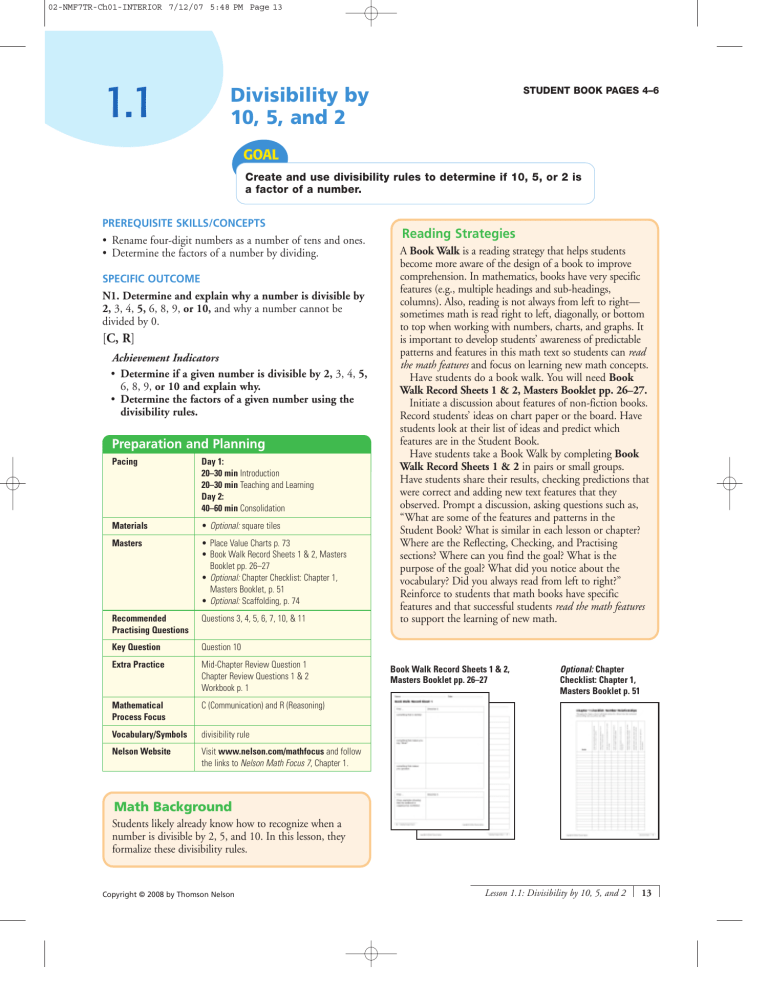
02-NMF7TR-Ch01-INTERIOR 7/12/07 5:48 PM Page 13
1.1
Divisibility by
10, 5, and 2
STUDENT BOOK PAGES 4–6
GOAL
Create and use divisibility rules to determine if 10, 5, or 2 is a factor of a number.
PREREQUISITE SKILLS/CONCEPTS
• Rename four-digit numbers as a number of tens and ones.
• Determine the factors of a number by dividing.
SPECIFIC OUTCOME
N1. Determine and explain why a number is divisible by
2, 3, 4, 5, 6, 8, 9, or 10, and why a number cannot be divided by 0.
[ C, R ]
Achievement Indicators
• Determine if a given number is divisible by 2, 3, 4, 5,
6, 8, 9, or 10 and explain why.
• Determine the factors of a given number using the divisibility rules.
Preparation and Planning
Pacing Day 1:
20–30 min Introduction
20–30 min Teaching and Learning
Day 2:
40–60 min Consolidation
Materials
Masters
• Optional: square tiles
• Place Value Charts p. 73
• Book Walk Record Sheets 1 & 2, Masters
Booklet pp. 26–27
• Optional: Chapter Checklist: Chapter 1,
Masters Booklet, p. 51
• Optional: Scaffolding, p. 74
Questions 3, 4, 5, 6, 7, 10, & 11 Recommended
Practising Questions
Key Question
Extra Practice
Question 10
Mid-Chapter Review Question 1
Chapter Review Questions 1 & 2
Workbook p. 1
C (Communication) and R (Reasoning) Mathematical
Process Focus
Vocabulary/Symbols divisibility rule
Nelson Website Visit www.nelson.com/mathfocus and follow the links to Nelson Math Focus 7 , Chapter 1.
Book Walk Record Sheets 1 & 2,
Masters Booklet pp. 26–27
Reading Strategies
A Book Walk is a reading strategy that helps students become more aware of the design of a book to improve comprehension. In mathematics, books have very specific features (e.g., multiple headings and sub-headings, columns). Also, reading is not always from left to right— sometimes math is read right to left, diagonally, or bottom to top when working with numbers, charts, and graphs. It is important to develop students’ awareness of predictable patterns and features in this math text so students can read the math features and focus on learning new math concepts.
Have students do a book walk. You will need Book
Walk Record Sheets 1 & 2, Masters Booklet pp. 26–27.
Initiate a discussion about features of non-fiction books.
Record students’ ideas on chart paper or the board. Have students look at their list of ideas and predict which features are in the Student Book.
Have students take a Book Walk by completing Book
Walk Record Sheets 1 & 2 in pairs or small groups.
Have students share their results, checking predictions that were correct and adding new text features that they observed. Prompt a discussion, asking questions such as,
“What are some of the features and patterns in the
Student Book? What is similar in each lesson or chapter?
Where are the Reflecting, Checking, and Practising sections? Where can you find the goal? What is the purpose of the goal? What did you notice about the vocabulary? Did you always read from left to right?”
Reinforce to students that math books have specific features and that successful students read the math features to support the learning of new math.
Optional: Chapter
Checklist: Chapter 1,
Masters Booklet p. 51
Math Background
Students likely already know how to recognize when a number is divisible by 2, 5, and 10. In this lesson, they formalize these divisibility rules.
Lesson 1.1: Divisibility by 10, 5, and 2 13
Copyright © 2008 by Thomson Nelson
02-NMF7TR-Ch01-INTERIOR 7/12/07 5:48 PM Page 14
1
Introduction
(Whole Class/Individual)
➧
20–30 min
to introduce students to the design and features of the
Student Book.
3 important for students to understand why these meanings are equivalent. (See Sample Discourse below.)
4 lesson, students must be able to use place value notions to of tens and ones. Have students use Place Value Charts p. 73 to rename some multi-digit numbers, especially three-
Thousands
7
1
8
Hundreds
2
Tens
3
10 2 12 3
120 3 123
Ones
5
5
5
Students should be able to rename a multi-digit number as a number of tens and ones without using a place value chart by forming a number from the left-most digits to the tens digit and then adding the number of ones:
1235 123 tens 5 ones
Students also need to know that if a number is a factor of another number, it is also a factor of the product when that other number is multiplied by another whole number. For example, 5 is a factor of 10, so 5 is a factor of 2 10, 3 10, and so forth. Because 2, 5, and 10 are each a factor of 10, each number is a factor of any multiple of 10.
Sample Discourse
Pose two division problems: “Three students have a total of
$12 to share equally. How much is each share?”
• $4
“Note pads come in a package of 3. How many packages are needed to have 12 note pads?”
• 4 packages
Draw 3 groups of 4 on the board. “Which of the division problems does this model show?”
Draw 4 groups of 3 on the board. “Which of the division problems does this model show?”
• Dividing 12 note pads into packages of 3.
“What is the meaning of this division?”
• Equal groups. The model shows the number of equal groups of
3 you can make with 12 items.
• They both represent the same division: 12 3 4 .
2
Teaching and Learning
➧
20–30 min
3
LEARN ABOUT the Math (Whole Class/Pairs)
• Dividing $12 equally between 3 students
“What is the meaning of this division?”
• Equal sharing. 12 3 4 is the amount each person gets if
12 items are shared equally among three people.
14 Chapter 1: Number Relationships then read the central question on Student Book page 4.
Ensure students notice the $2, $5, and $10 values on the
5 they will use reasoning to solve the problem. Discuss with students what they know: there are three card prices and
6 just one type of card. Note that if all the amounts raised can
7
Copyright © 2008 by Thomson Nelson
8
02-NMF7TR-Ch01-INTERIOR 7/12/07 5:48 PM Page 15
“You can divide in parts in a variety of ways. Model this division: 16 4 12 4 4 4.” Allow students to try for themselves, and then demonstrate how this is done for the class.
be divided by 2, 5, and 10 (i.e., all had 2, 5, and 10 as factors), you wouldn’t be able to solve the problem. So there must be a way to eliminate some of the options.
Next, discuss how if a number is a factor of two other numbers, then it is also a factor of their sum. You can demonstrate this using square tiles.
Sample Discourse
“Create an array to show 16 4 4.”
“So, you can divide a number into parts to divide it. What if you have any two numbers—let’s look at 16 and 6. How can you tell what factors the two numbers and their sum share?
What are the factors of 16?”
• 1, 2, 4, 8, 16.
“What are the factors of 6?”
• 1, 2, 3, 6
“Can you divide 16 into 3 or 6 equal groups?”
• No
Stroke out 3 and 6 in the list of factors of 6. “Can you divide
6 into 4, 8, or 16 equal groups?”
• No
“How about 2? Can you divide 16 and 6 into 2 equal groups? Explain.”
• Yes, because 2 is a factor of both numbers.
“So, can you divide 16 6 by 2?”
• Yes
“Can you divide 16 6 by 3?”
• No
“Let’s look at it another way. Since 2 is a factor of 6, and 2 is a factor of 16, 2 is also a factor of 6 16.” Have students test a few more combinations of numbers and ask if they can create a rule. Post the rule.
Provide students with place value charts. Work through
Prompts A and B together as a class. After reading Prompt B, draw students’ attention to the Communication Tip, which includes the meaning of the word divisible . Have students work in pairs to complete Prompts C to E. Have students share their solutions with the class.
“You can also divide in parts. You can split the dividend
(the number that is divided into equal parts in a division operation) into two different parts. Model this division:
16 4 8 4 8 4.” Allow students to try for themselves, and then demonstrate how this is done for the class.
Copyright © 2008 by Thomson Nelson
Lesson 1.1: Divisibility by 10, 5, and 2 15
02-NMF7TR-Ch01-INTERIOR 7/12/07 5:48 PM Page 16
Answers to Learn about the Math
A.–D.
See explanations for Prompts B to D below.
Thousands
1
Hundreds
9
Tens Ones
9 5
199 5
Thousands
1
Hundreds
0
Thousands
1
Hundreds
6
Tens
2
Ones
0
102 -
Tens
3
163
Ones
4
4
B.
For example, 10 can be divided by 10, 5, and 2. So
102 tens can be divided by 10, 5, and 2.
C.
For example, I know 5 divides 10 so it can divide 199 tens. Also, 5 divides 5 ones, so 5 must divide 1995. Both
2 and 10 can’t divide 1995, because neither divides the 5 ones.
D.
For example, I know 2 can divide ten so it can divide 163 tens. Also, 2 divides the 4 ones, so 2 must divide 1634.
Both 5 and 10 can’t divide 1634 because neither divides the 4 ones.
E.
The number 1995 is divisible only by 5, so Mountain
Heights sold the $5 card. The number 1634 is divisible only by 2, so Plains View must have sold the $2 card.
Therefore, by elimination, Lavalie must have sold the
$10 card.
Reflecting (Whole Class)
Here students reflect on what they learned in the activity and communicate their reasoning. Discuss these questions as a class. In Prompt F, students should recognize that the remainder can be determined by dividing only the last digit of a multi-digit number when dividing the number by 2, 5, and 10. Ensure students understand that all the other digits
(place-values) can always be divided by 2, 5, and 10. So, since we know that they can be divided, we only need to check the last digit to see if it can be divided. For example,
2456 = 2000 + 400 + 50 + 6. Each of the first three numbers in this sum can be divided by 2, 5, and 10, so you only have to worry about the 6, which can only be divided by 2. For
Prompt G, have students recall the patterning work done in the Getting Started activity to help them identify what the ones digits must be in each case. Then, draw students’ attention to the highlighted definition of divisibility rule.
Ask students how they can use their answers to Prompt G to answer Prompt H.
Answers to Reflecting
F.
For example, if I regroup a whole number as a number of tens and ones, I know the number of tens can be divided by 10, 5, and 2. So I just have to look at the last digit. If it can be divided evenly by 10, 5, or 2, then so can the entire number. If the last digit cannot be divided evenly, the remainder after dividing it by 10, 5, or 2 is the remainder when the entire number is divided by 10, 5, or 2.
G.
For example, if a number is divisible by 10, the ones digit is 0. If it’s divisible by 5, the ones digit can be 5 or 0. If it’s divisible by 2, the ones digit can be 2, 4, 6, 8, or 0.
H.
For example, I just need to check the ones digit. A number is divisible by 10 if its ones digit is 0. A number is divisible by 5 if its ones digit is 0 or 5. A number is divisible by 2 if its ones digit is even.
16 Chapter 1: Number Relationships
Copyright © 2008 by Thomson Nelson
02-NMF7TR-Ch01-INTERIOR 7/12/07 5:48 PM Page 17
1
2
3
Consolidation
➧
40–60 min
WORK WITH the Math (Pairs/Whole Class)
4 have any questions. Note the steps Ryan uses: 1) rename the
Checking (Pairs)
6 Place Value Charts p. 73.
Have students work in pairs. For Question 1, suggest that students follow the format of the example in the Student how to use the divisibility rules to determine a remainder.
Sample Discourse
8
• 1
“Why does knowing the remainder of 7 2 also tell you the remainder of 27 2?”
• When you divide a number by 2, you know the tens and up are divisible by 2, so you just need to check the ones. If they aren’t divisible by 2, the part left over when you divide by 2 will be the remainder.
“Can you also use the divisibility rules for 10 and 5 to determine the remainder if you divide by 10 or 5? Explain.”
• Yes, because to see if they divide a number, you only have to look at the ones digit.
“What is the remainder when 34 648 is divided by 5? How do you know?”
• 3; 8 5 1 R3
Practising (Individual)
These questions give students opportunities to practise using the divisibility rules and to see their power. Allow students time to complete a fair selection of these questions, as practising is key to students gaining comfort and confidence with the rules. Provide place value charts for those who need them.
3.
Students will use the knowledge that when you multiply or divide a number by 1, the answer is the number you started with.
4. & 10.
If extra support is required, guide those students and provide copies of Scaffolding, p. 74.
8.
Students should know that 1000 is divisible by 20, because 20 is a factor of 100 and 1000 10 100.
They can list other multiples of 20 greater than 1000 by adding 20 and arranging these multiples in rows of 5.
1000, 1020, 1040, 1060, 1080,
1100, 1120, 1140, 1160, 1180
Students can see that numbers are divisible by 20 if the last 2 digits are 00, 20, 40, 60, 80, or 00 or all are multiples of 20.
9.
Students might use a place value chart to represent each step of the number trick. For example, 13 counters might represent a student’s age:
Hundreds
Age
2
5
Regrouping {
Remove the last digit
Age
1
1
Tens
1
2
10
13
3
3
1
Ones
3
6
30
0
3
0
0
Answer to Key Question
10.
For example, the number must end in 0 to be divisible by 10. That means it is also divisible by 5 and by 2. The greatest number between 900 and 1000 that ends in 0 is
990, and the least is 910.
Closing (Whole Class)
Question 11 allows students to reflect on and consolidate their learning for this lesson.
Answer to Closing Question
11.
For example, they are similar because they all look at only the ones digit. They are different because the divisibility of 10, 5, and 2 depends on the value of the ones digit in different ways. A number must have 0 in the ones digit to be divisible by 10, it must have 0 or 5 in the ones digit to be divisible by 5, and it must have an even number in the ones digit to be divisible by 2.
Follow-Up and Preparation for Next Class
Ask students to think of real-life situations in which the divisibility rules for 2, 5, and 10 might come in handy.
Point out Questions 5 and 6 as examples.
Lesson 1.1: Divisibility by 10, 5, and 2 17
Copyright © 2008 by Thomson Nelson
02-NMF7TR-Ch01-INTERIOR 7/12/07 5:48 PM Page 18
Opportunities for Feedback: Assessment for Learning
What you will see students doing
When students understand If students misunderstand
• Students rename a number as a sum of tens and ones and look at the ones digit to determine whether a number is divisible by 2, 5, and 10. They explain their reasoning.
• Students develop and explain divisibility rules for 2, 5, and 10.
• Students may not be able to rename a number as a sum of tens and ones.
(See Extra Support 1 and 2.)
• Students may not realize that if a number is divisible by 10, it is also divisible by 5 and 2. (See Extra Support 3.)
• Students may determine divisibility by dividing the complete number, rather than using divisibility rules. (See Extra Support 4.)
• Students may not understand why examining only the ones digit can determine divisibility by 2, 5, or 10. (See Extra Support 5.)
Key Question 10 (Communication, Reasoning)
• Students use divisibility rules for 2, 5, and 10 to solve a problem and explain their thinking.
• Students may not be able to devise an efficient strategy using the divisibility rules. They may guess and test. (See Extra Support 6 to 8.)
Differentiating Instruction: How you can respond
EXTRA SUPPORT
1.
Our base-10 system and place value system for representing numbers are conventions; they are not implicit in what number is all about. Because they are conventions, they must be explicitly taught. Make sure students understand the following:
– We group in tens for convenience so that we only need 10 digits (0–9) to represent all numbers.
– Each place value is 10 times the value of the place to the right.
– A place value requires a symbol for a placeholder. For example, the 0 in 506 pushed the digit 5 over to show that it represents 500 instead of 50. Then explain that a number has many different forms. For example, 123 is 1 hundred, 2 tens, and 3 ones; it is also 12 tens and 3 ones. Some students will only require extra practice renaming numbers in expanded notation to become comfortable with this concept. Others should model numbers using base ten blocks and then a place value chart. Place value charts allow for a transition from the blocks, which inherently have no place value, to numerals, which consist of digits that have place value.
2.
Suggest that students use calculators to explore place value concepts. For example, they can add 100 ten times on a calculator to see the pattern: 100, 200,
300, … up to 1000. This solidifies the notion that 1000 is 10 hundreds. Similarly, students can divide 1000 by 100 ten times to see that it is 100 tens.
4.
Provide extra practice using the divisibility rules to determine divisibility.
Students can play a game, in pairs, using number cards (0–9) where each player takes turns to draw four cards and create a four-digit number. The other player uses divisibility rules to determine if the number is divisible by
2, 5, and/or 10, using a calculator to check and winning a point for each correct answer. This game can also be played to practise other divisibility rules as they are learned.
5.
Ask students if 10 is divisible by 2 and by 5. Ask, "If the last digit of a number is 0, does that mean that it is divisible by 10? Is a number that ends in 0 divisible by 5? Is it divisible by 2?" Ask students to explain why, if a number is divisible by 10, it also is divisible by 2 and 5.
6.
Remind students that, by using divisibility rules, they can merely look at the number and do not have to actually divide.
7.
Simplify the problem by using smaller numbers. Ask students, "If a number is divisible by 2, 5, and 10, what can the ones digit be?" Then ask them to use the divisibility rules to identify the greatest and least number between 90 and 100 that is divisible by 10, 5, and 2. Then have them apply the strategy to correctly answer the question.
8.
Use Scaffolding for Lesson 1.1, Questions 4 & 10 p. 74 to provide steps.
EXTRA CHALLENGE
Pose problems such as these:
• Is it possible to create multi-digit numbers that are divisible by two of the numbers 2, 5, and 10 but not by all three? Explain your reasoning.
• Create your own word problem where the divisibility rule for 2, 5, and 10 would assist in the solution. Trade problems with a classmate and solve each other’s problem.
• The ancient Sumerians used a base-60 place value system, and the Maya used a base-20 system. Use your understanding of the base-10 place value system to determine what a Mayan or Sumerian place value chart would look like.
18 Chapter 1: Number Relationships
Copyright © 2008 by Thomson Nelson
